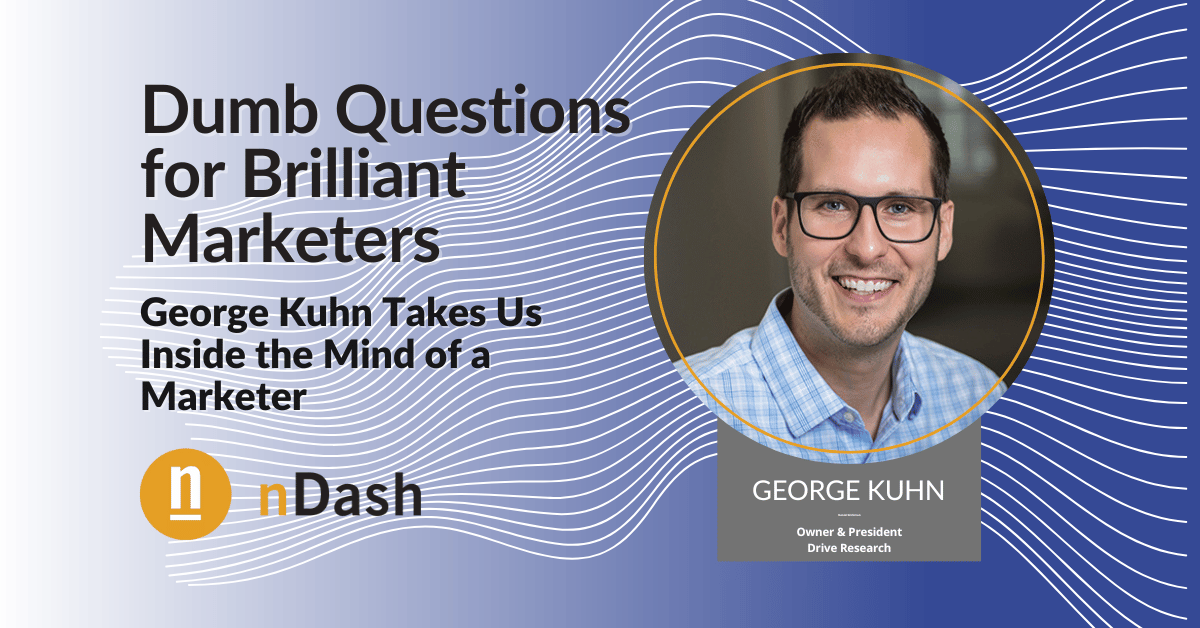We’re back with another marketer interview as part of our Dumb Questions for Brilliant Marketers series. This time, nDash’s Managing Editor, Jenn Greenleaf, talks to Drive Research’s owner and president, George Kuhn, about all things marketing.
Jenn: Thank you for taking the time to meet with me today! Could you give our readers some background on who you are and what you do?
George: My name is George Kuhn, and I’m the owner and president of Drive Research. We’re a full-service market research company headquartered in Syracuse, New York. But we have staff all over the country and clients all over the world. We work with everyone from startups launching a new business concept or idea all the way up to Fortune 50 companies like Amazon and Google.
Additionally, we run the gamut of qualitative and quantitative market research services, everything from focus groups to surveys. Our market research team focuses on consulting with clients to get answers to their questions. It includes their customer audience or general market.
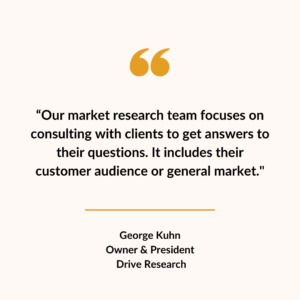
Drive Research also interprets that data and provides back some recommendations and analysis to help drive their marketing and their strategy – and their content in many cases.
Our market research company launched in 2016. We are kind of a small but growing force in the market research industry. We have soon-to-be 15 full-timers and a handful of part-timers to help us with phone surveys, qualitative recruiting services, and things like that.
Jenn: nDash recently engaged with Drive Research to do some marketing research for one of our brands. The results were pretty cool – I really liked how it all turned out.
George: Our industry really lends well to content, right? You see a lot of studies out there where people are looking to get press or generate content. And, in my opinion, I mean, I’m obviously biased, but there’s no better way to do that than with fresh insights and fresh data.
Research over the decades has always been very stuffy, confidential, NDA-ish, don’t share that in your data, etc. However, the content world has really changed, and people are using studies to share data, build awareness, and generate leads.
And it’s a nice evolution, too, because, as a company, it’s also helped us share our work a lot more. Because when a client comes to us and says, can you show us an example of what you do? Usually, the standard answer was sorry, we have an NDA in place.
Now, we point them to our survey findings featured on CNBC or USA Today for this brand and this client, so definitely cool.
Jenn: That’s also helpful from a writer’s perspective. I’m constantly encouraging writers to dig deep into the data. And if they have surveys like the ones that you’re providing, that is super helpful, especially when they’re current. We run into several issues where an article written in 2023 will quote a survey from 2017. And that’s not valuable.
George: We’re huge fans of backlinks and trying to get fresh data on our website and our market research company blog. Maybe that’s why I get along with Mike at nDash so well. But I’m just a huge fan of content, a big believer in that. If you look at our website, we have over 1400 blog posts. This is pretty unheard of for a market research firm or many firms of our size.
We’re blogging every day, even Saturday and Sunday. And we generate a lot of inbound leads, a lot of awareness, and a lot of our new or repeat business through the content we write.
Jenn: And, as a marketing tool, do you feel like content marketers should be using surveys more?
George: 100% – whether they use us for PR surveys and content surveys, a competitor, or DIY survey tools, there are a ton of resources that can help. We do find places where we can source a unique data point that has a much higher chance of being picked up from notable media and news outlets.
Journalists are pitched information and stories all day long. It can be hard to break through the noise. However, from our experience, we find that data and unique insights are always at the top of the list in terms of them being interested in your pitch.
If you can include relevant insights and original research, you stand a much greater chance of generating some awareness and attention from different journalism brands.
Jenn: So when trying to generate awareness and attention, what mistakes do you see marketers making most often?
George: As a pure researcher, the science and the methodology behind the surveys are not always spot on. You’ll see a lot of brands and companies pitching their own customer data as part of a pitch, and journalists are very smart with that.
They realize who you’re surveying and if you’re trying to pitch them results from, say, 50 of your customers. They understand statistical reliability and margin of error a bit, and when you are pitching broader insights using your customer database it’s not really representative.
There’s obviously an inherent bias with that versus doing a general public opinion survey. So there are mistakes there with the science and the research, how it’s done, and the number of responses, how the question was asked – we could spend another hour talking about the science of question writing.
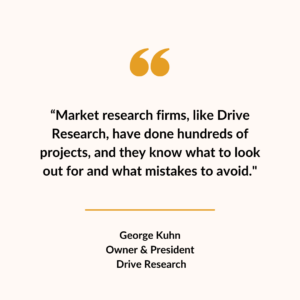
And that’s why, as part of our value add, we try to communicate the science of writing and how to ask a question the right way to get real results. And you see a lot of the studies that have been published, and the questions are a tad biased to get the angle they want. They know what angle they want.
For example, political surveys that are done around the presidents. They send those out to get favorable opinions and data back to report on. They’ll make a very biased statement about, “President ABC helped the economy grow 23% last year, created 10% more jobs, and decreased our debt by 8%; how do you feel the President performed in his last term?”
That’s not good question writing. They’re obviously trying to steer you in a positive or negative direction. You need to use an independent third party and expert market research firm that’s done it time and time again. Market research firms like Drive Research have done hundreds of projects, and they know what to look out for and what mistakes to avoid.
Jenn: You mentioned that you have a pretty aggressive blog schedule where you’re using posting on Saturdays and Sundays. Do you see value in outsourcing your content, or do you find the most value in writing it in-house?
George: It’s about half and half. Research as a topic is very niche. For some of the details we get into with our methodologies and approaches, you have to have some knowledge of research or at least the benefits of it to really write about it.
Our team, internally, can nail that.
For example, we might need to find someone to write about factor analysis for a segmentation study. They’re not many freelancers growing on trees who can touch on that topic. We have some really tough topics that make it difficult for us to outsource a post like that.
But we’re finding as our content strategy grows and we have more and more stuff on the blog, we are approaching exhausting all of our research topics.
So our new angle that really works for outsourcing is can we start to create some more niche posts around certain sectors that we do a lot of work in? Like financial services such as banks and credit unions. We can find somebody who’s worked in that space and is very comfortable writing about that topic. Then, we can add a layer above research, where it’s how to grow your customer base at your bank, and they can talk about marketing and strategy there. And then maybe tie in surveys and research as part of that post.
It’s like a layer above the sale – here’s some traffic we can generate from our content where somebody’s looking for some general banking strategies, and oh, by the way, surveys can help you accomplish those. Those topics we find to be a great fit when we’re looking for specialized industries in specialized backgrounds. A platform, again, like nDash, offers a lot of flexibility there to dip into that audience.
Jenn: You mentioned that you’re building out your content strategy. Aside from blog content, have you experimented with any other forms of content? Like maybe YouTube videos or TikTok or Snapchat, or things like that?
George: We have general social pages for content where we’ll feature company news, blog posts, or light-hearted data such as Valentine’s Day statistics. However, we’re a B2B professional services firm, and our target market is a B2B buyer. So we tend to relegate our strategies mostly to LinkedIn for blog content sharing. That’s, that’s the best fit for us.
Drive Research is also active on YouTube. We repurpose our blog posts into short, digestible videos as part of our 0 to 60 video series.
We’ve increased our usage of gated content, too, for some of the more intricate content we write, where we’re really diving into an ultimate guide or specialized downloadable content. We’ll put that behind a wall where we’re doing a form fill-in to generate leads.
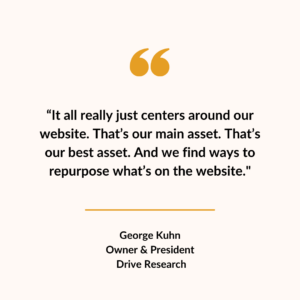
It all really just centers around our website. That’s our main asset. That’s our best asset. And we find ways to repurpose what’s on the website.
From new leads, we often get questions like, “Can you send us a capabilities packet? Or presentation?” That question is frustrating because, once you create that presentation, it’s out of date. Our website really is our best asset; it is always live and up to date. And here are all the pieces that you’re used to getting into the capabilities packet, but sorry, it’s not an attachment. It’s living and breathing on the site, and we’re benefiting from that.
Jenn: I’m glad you brought up gated content. I was wondering, do you find that gated content provides or causes some sort of roadblock sometimes, or do you feel like it’s successful in terms of the results you want to see?
George: It’s a little bit up and down – it depends on what value you’re offering. So, for example, the cannabis industry is huge. Right now, we have a lot of content about how research can help with that strategy. It’s such a new field; there’s really not a lot of information and data out there on it yet. So we’re working on a cannabis market research report to put behind a form fill. The goal is to earn a lot of downloads and generate leads from that or even sales.
But the issue we run into with form fills is more general information or stuff that we think has less value. Unfortunately, there are 100 other websites where somebody can go and find something equivalent for free, or they don’t have to offer up their contact information. So really, it comes down to the uniqueness of what you’re sharing. And if it’s too general, and you’re not really communicating the value of the piece. It’s definitely a barrier.
Jenn: So, with unique content, it brings up the controversial topic of AI. Do you feel like that’s something that marketers should embrace or run away from?
George: That’s definitely a loaded question and a lot to unpack with that. Right? Because, purely from a research standpoint, one of the biggest fears we have with AI is from a survey respondent perspective.
So we’re, in many cases, using online panels to target samples, and we ask open-ended survey questions, and there’s always fraud to identify and remove. We have a ton of data quality checks to try to mitigate that and eliminate it. But one of which is the quality of the open-ended answer where now someone can appear to be an expert in any topic and write a really good response. So good that when you read it, it’s like, “Is that really a person saying that, or is that a robot?” That’s the challenge on the research side of it.
On the marketing side, we don’t support it for ground-layer content creation. We feel it’s just another kind of evolution of a tactic.
For instance, you see the white hat and black hat backlink things over the years that Google got smart with. I do think that, eventually, Google is going to get very smart with AI content. And I think it’s going to be a digital watermark or some kind of disclaimer, or people have to mention they use AI down the road. I can’t imagine Google as the main player in the space for SEO, in particular, allowing it. They don’t like people gaming the system and fast-tracking things, and I feel like AI is a great way to fast-track that. I think at some point, Google and other search engines are going to crack down on it.
It’s actually a conversation we had with our staff a few weeks ago because all of our team writes content for our website. We explained and communicated why we’re taking a longer-term play here. We do expect there may be some short-term drawbacks where you have firms that couldn’t find the time to do content and are now pumping out ten blog posts a day just randomly. But we do feel like the wrong place is doing it the right way through some type of human-generated content.
Jenn: Do you feel like AI would be a useful tool for ideation or making outlines or things like that? Where it’s not really diving deep into the core of the content but instead informing it?
George: 100%. You just have to be careful with how you use it. But in terms of structuring or generating ideas, different spins, different takes, or outlines, as you said, I do think there’s a place for that. Though, I wonder how much of it is just a rehash of the same old thing. The AI are patterns, so they can often repeat the same things back to different people for similar questions. It’s the AI bot telling you the same thing that it is telling someone else. So, at the end of the day, is everybody doing the same thing or writing too-similar content? Even though they think they’re generating fresh content, I wonder about that. But there are definitely a ton of benefits and significant risks. You just have to be smart about how you use AI in content marketing.
Jenn: Okay, so aside from market research, what do you feel is the most underutilized tool and a marketer’s arsenal?
George: As the market researcher, I would definitely say the data analytics piece is the big one. But, I do think another underutilized tool is the ultimate guides and other gated assets. You can generate a lot of warm leads through that strategy. The issue is when you have a high-performing website and you’re generating a lot of page traffic, 99.9% of the visitors are just stealth. You don’t know who they are. You do your best to try to get their contact information unless you’re doing some type of form fill where you’re making that transaction and collecting that information.
In many ways, you’re hoping that they eventually reach out to you. But if you do something with a form fill, you can collect those contacts and collect this information before they bail.
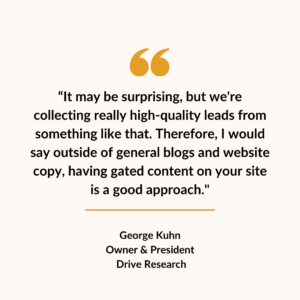
Though again, to my prior points, it has to be the right topic and offer enough value. For example, we recently did a grocery segmentation report where we outlined segments of grocery shoppers across the United States. We get daily requests through form fills for it.
And that’s something that’s really valuable for any kind of brand that plays in the grocery space that wants to see that. It’s not something you can just go search Google and download someone else’s segmentation report. With this in mind, we put that behind a form fill, and it’s incredible the leads we get from that every day. For instance, we’ve gotten downloads from contacts working at Instacart and Kraft Heinz. It may be surprising, but we’re collecting really high-quality leads from something like that. Therefore, I would say outside of general blogs and website copy, having gated content on your site is a good approach.
Jenn: How often are you creating this gated content? Is it several times quarterly or several times monthly?
George: We have an outline for the year. But depending on workflow, it goes a little bit in the ebbs and flows. But we’re making a conscious effort to do something new each quarter in 2023. Sometimes there are multiple pieces there if there are other things that we found. And other mini-projects with form fills.
We’re also toying with syndicated content, too. That’s a form of gated content but an actual transactional sale where they buy a report for different reasons. As you look at our smaller business, we try to grow in scale. The more we can do of that, and we’re generating more leads, even transactional sales on the website, you can open up a lot of doors for us to scale more quickly.
Jenn: Okay – one last question, marketing to marketers is __________.
George: Challenging. Because I feel what you do when you’re in the marketing game, and you’re marketing to a marketer, they kind of know the approach. They know what you’re going to say as the benefits, and they can kind of very much, in many ways, see through that, right? We even see that on our end when someone’s marketing to us.
With the amount of leads we have, in some situations, we tend to be very blunt and very direct and not beat around the bush. What do you need? Here is the timeline, the cost, the scope, etc. No sense in trying to kill them with marketing content and why we are the greatest company on the planet. It can fall on deaf ears to a marketer or turn them off. It’s challenging.
About George Kuhn:
 George Kuhn’s passion for helping others reach their goals with market research is the “driving” factor behind the launch of Drive Research in 2016. He’s known from a young age that businesses need data to help “drive” them toward success. As someone who’s naturally curious and loves asking questions, his market research company helps uncover the stories behind the data.
George Kuhn’s passion for helping others reach their goals with market research is the “driving” factor behind the launch of Drive Research in 2016. He’s known from a young age that businesses need data to help “drive” them toward success. As someone who’s naturally curious and loves asking questions, his market research company helps uncover the stories behind the data.
